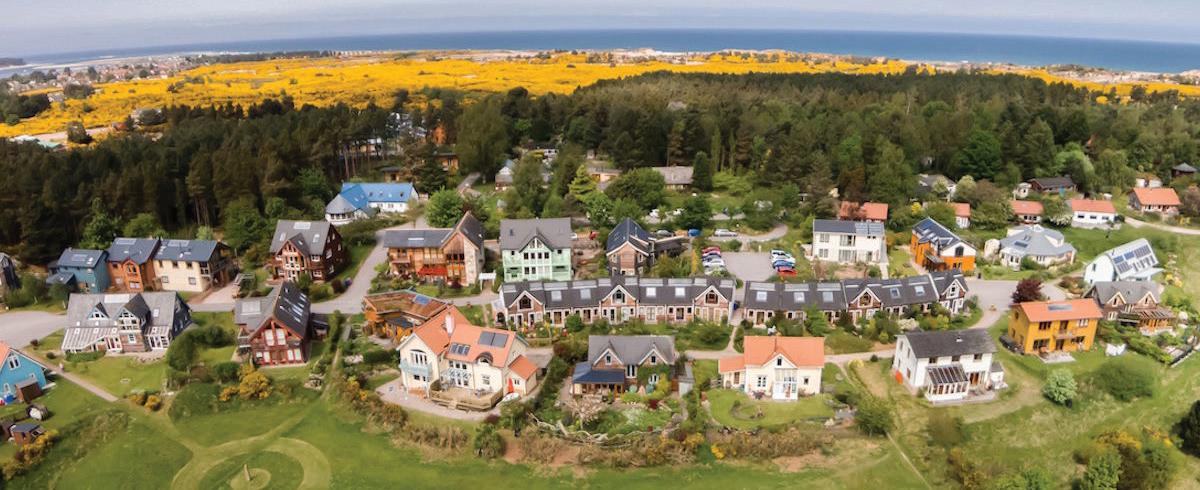
3 minute read
Findhorn Ecovillage p
Student:
Capucine Marie Verbrugge
Advertisement
Study:
Findhorn Ecovillage : Environmental-friendly and self-sufficient
Keywords:
sustainable community, water, energy
The Findhorn Ecovillage is a project initiated in the 1980’s and is maybe one of the best example of a self-sufficient community. It is located at The Park in Moray in the North-East of Scotland. The aim of the village was to develop a community that lived in a sustainable environment. The entirety of the village is self-sufficient, from the houses’ architecture to the treatment of the water and renewable energies.
Regarding architecture, the Findhorn Ecovillage has extensive building rules required as they are trying to be environmentally responsible and construct zero carbon homes. Indeed, households necessitate insulation made out of recycle paper and cardboard alongside organic and harmless paints, glues and resins and natural tiles for the roof. Also, to limit waste of energy, inhabitants of the ecovillage are equipped of low-energy light bulbs, “breathing walls” allowing exchange of air and are sharing facilities such as laundry, kitchen, etc.
A lot of building in this community are possessing photovoltaic panels supplying enough electricity and heating energy but they are also designed in favor of passive solar radiation. Passive solar radiation is the smart way of placing windows, walls and floors to optimize the reflection, the storage and the distribution of solar energy to either cool or heat the building. Additionally, to provide energy to all households, the Findhorn Ecovillage has its own wind park containing four wind turbines that provides a capacity of 750kW and supply more than 100% of the community. On the other hand, the village has an ecological waste water treatment thanks to 1995 Jonathon Porritt’s invention: the first Living Machine or known as Eco-Restorers. The machine is designed to treat sewage from a population up to 500 people who are living in the Findhorn Ecovillage. The whole process of the water filtration is done by a community or bacteria, algae, micro-organisms and many more.
One of the Findhorn Ecovillage greatest accomplishment is that they have the lowest ecological footprint of any community in the industrialized world. This is due to all the sustainable inventions and way of living but also due to their food consumption. Indeed, they have built a village that support organic farmers in the area and permaculture.

Student:
Emanuel Hempel
Study:
The BIQ-House: an analysis of its feasibility for future large scale implementation
Keywords:
energy, building-scale
In the following case study I will take a closer look at the „BIQ-House“ which can be found on a plot of land belonging to the “international Bauausstellung” in Hamburg, Germany. This unique project, lead by the Biotech company SSC, has an estimated cost of 5 million euros and was awarded with several prizes ranging from the ‘Land of Ideas’ to the ‘Deutsche Fassadenpreis 2013’ and the Zumtobel Group Award 2014 in the category of “Applied Innovations”.
The design takes advantage of the process of photosynthesis, to generate energy. Structurally the system is made up of 129 sun-tracking reactor models also referred to as photobioreactors (PRBs) which are 270cm high and 70cm wide. The origin of the questionable green color stems from the microalgae found inside of the tanks, acting as a bioreactor, while simultaneously creating the facade of the building. CO2 is added to the culture, serving as a nutrient, for which a flue gas stemming from a biogas-fueled micro-combined-heat-and-power-unit is utilized. The CO2 allows for the growing algae to be converted into biomass. Additionally oxygen is filtered into the tanks, which causes the algae to get circulated, allowing all algae to get exposed to sunlight. The growing microalgae, resulting from the constant turbulence and exposure to sunlight, produces heat (at a efficiency of
38%, twice as low as conventional solar thermal) and biomass (at 10% efficiency compared to 15% with conventional PVs).
This system generates energy both through the excess of sunlight, not converted by the microalgae, exactly like the process found in solar thermal units and through harvesting the algae biomass energy. The energy is used either directly for hot water and heating, or stored in the ground through bore-hole heat
exchangers.
Although the project seems promising boasting a energy conversion efficiency of 48%, perceived to be an excellent rating, while providing other considerable advantages including; insulation form sound, heat and cold and the provision of shade from sunlight it does have flaws.
First of all, the turbulence caused by the water circulating within the tanks, causes noise pollution. Furthermore the system was not self-sufficient at a constant level, requiring excessive maintenance and monitoring. Lastly the project is capital intensive, lacking the economies of scale to makes this an economically feasible solution in the present time.








